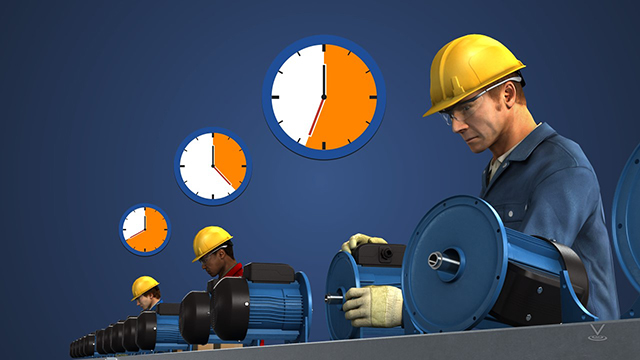




Lean Manufacturing: Standardized Work
This training course provides an approach to managing documented instructions, known as standardized work. This lean manufacturing tool provides a clear communication of steps to be met when performing a job, allowing sustainability of continual improvements in the manufacturing setting.
Request a demoCourse Details
Learning Objectives
- Recall the concept of standardized work in a Lean environment
- Identify the elements and tools used to implement standardized work in a Lean environment
- List the steps to implement standardized work practices
- State the importance of focusing on Lean standardized work
Specs
| Course Level | Intermediate |
| Languages | English |
| Compatibility | Audio, Video |
| Based on: | Industry Standards and Best Practices |
Key Questions
How do you define standardized work?
Standardized work is a detailed, documented, and visual system of steps within a process, sequenced without waste, to achieve the most efficient level of production. It is a combination of methods, tools, and documents that describe the best way to execute a process in order to maintain consistent working practices.
What is the most common way to develop, document, and use standardized tasks?
The most common way to develop, document, and use standardized tasks is through standard operating procedures (SOPs). To establish an SOP, it is important to be able to clarify and share information about the most efficient method that can be replicated when completing tasks.
What some examples of standardized work?
Examples of standardized work include specific task procedures like how to install a bolt, line setup/changeover processes, and safety procedures such as lockout/tagout.
How do you define work-in-process (WIP)?
Work-in-process (WIP) relates to manufactured products that have been partially completed. Lean strives for one-piece flow to achieve just-in-time production. This suggests that the parts between operations would be set-up in a minimal quantity.
What tools can be used to implement standardized work?
Process capacity sheets, standardized work charts, and standardized work combination charts can be used when implementing standardized work.
Sample Video Transcript
Standardized work is a detailed, documented, and visual system of steps within a process, sequenced without waste, to achieve the most efficient level of production. The main goal is to show how the job is done with clear procedures for operators. It is a combination of methods, tools, and documents that describe the best way to execute a process in order to maintain consistent working practices, ultimately resulting in consistent product development. The most common way to develop, document, and use standardized tasks is through standard operating procedures (SOPs). To establish an SOP, it is important to be able to clarify and share information about the most efficient method that can be replicated when completing tasks. Everyone should then keep promoting continual improvement to the standards and share new best practices as they are defined. The SOP will not be perfect; therefore, you should consider maintaining living documents that evolve over time. It sets the baseline upon which processes stand. As the standard is improved, the new standard will become the baseline for further improvements. We often see individuals choosing their own methods and sequences when completing their work. While great ideas can be gained from individualized ways, companies need to document the information collectively and consolidate these practices. Otherwise, every time a person is absent, the process will be altered if someone else does it differently. Standardized work also eliminates the habit of personnel working from memory. The expertise needs to be maintained within the organization. Otherwise, over time, the skills needed to perform the tasks may no longer be available to the company. Standardized work also ensures consistent training results. At this point, it is important to make a differentiation between “standardization” and “standardized work.” A common definition of standardization is the process of conforming to a standard within a given industry. Standardization also provides brand recognition. Examples of standardization include: • Manufacturing practices that specify heat treatment after welding to relieve internal stresses. • Products sharing a recognizable appearance (such as mobile phones, car brand models, etc.). • Chain restaurants with specific recipes and ingredients for all the food offered as well as specific ways of serving it. • Traffic signs such as the red stop sign. It has a specific shape and color that people all over the world have learned to recognize and react to when they see it. Standardized work, however, can be defined as having personnel performing the tasks in the same way, all the time, eliminating ambiguity and inconsistency within the process. Examples of standardized work include: • Specific task procedures, like how to install a bolt • Line setup/changeover processes • Safety procedures like lockout/tagout Standardized work improves safety and quality by having repeatable processes. It increases efficiency because the elimination of waste is always considered. Standardized work also encourages the use of documents like: • Product drawings • Work instructions • Tooling layout drawings • Calibration instructions Standardized work is not just a set of repeatable instructions. It’s a whole packaged system that is detailed, documented, and highly visible.
Course Applies To
Demos + Pricing
Learn more about our courses, get pricing, and see our platform.











